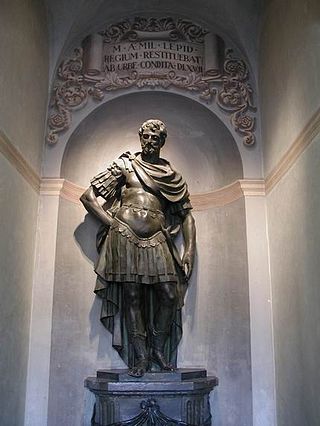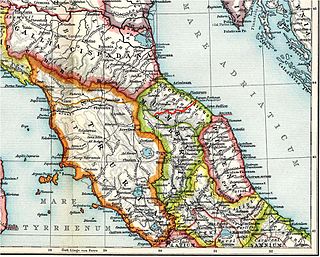Related Research Articles
This article concerns the period 229 BC – 220 BC.
Year 225 BC was a year of the pre-Julian Roman calendar. At the time it was known as the Year of the Consulship of Papus and Regulus. The denomination 225 BC for this year has been used since the early medieval period, when the Anno Domini calendar era became the prevalent method in Europe for naming years.

Gaius Flaminius was a leading Roman politician in the third century BC. Flaminius served as consul twice, in 223 and 217. He is notable for the Lex Flaminia, a land reform passed in 232, the construction of the Circus Flaminius in 221, the construction of the Via Flaminia, and his death at the hands of Hannibal's army at the Battle of Lake Trasimene in 217, during the Second Punic War. Flaminius is celebrated by ancient sources as being a skilled orator and a man possessed of great piety, strength, and determination. He is, however, simultaneously criticised by ancient writers such as Cicero and Livy for his popular policies and disregard of Roman traditions, particularly during the terms of his tribunate and second consulship.

Marcus Aemilius Lepidus was a Roman consul, Pontifex Maximus, Censor and Princeps Senatus. A scion of the ancient Patrician gens Aemilia, he was most likely the son of Marcus Aemilius Lepidus, with his brothers being Lucius and Quintus.

The Battle of Telamon was fought between the Roman Republic and an alliance of Celtic tribes in 225 BC. The Romans, led by the consuls Gaius Atilius Regulus and Lucius Aemilius Papus, defeated the Celts led by the Gaesatae kings Concolitanus and Aneroëstes. This removed the Celtic threat from Rome and allowed the Romans to extend their influence over northern Italy.
Titus Manlius Torquatus was a politician of the Roman Republic. He had a long and distinguished career, being consul in 235 BC and 224 BC, censor in 231 BC, and dictator in 208 BC. He was an ally of Fabius Maximus "Cunctator".

The Battle of Placentia was fought in 194 BC, near Placentia, between the Roman Republic and the Boii. The Roman army won the battle. The following year, another battle with the Boii would take place in the same region; known as the Battle of Mutina, it would end the Boii threat.
Marcus Atilius Regulus was a Roman politician and statesman. He was consul in 227 and 217 BC and later censor in 214 BC. He was the son of his homonymous father who was consul in 267 and 256 BC.

The Insubres or Insubri were an ancient Celtic population settled in Insubria, in what is now the Italian region of Lombardy. They were the founders of Mediolanum (Milan). Though completely Gaulish at the time of Roman conquest, they were the result of the fusion of pre-existing Ligurian and Celtic population with Gaulish tribes.
The Gaesatae or Gaesati were a group of Gallic mercenary warriors who lived in the Alps near the river Rhône and fought against the Roman Republic at the Battle of Telamon in 225 BC.
Lucius Aemilius Papus was a Roman general and statesman. He jointly commanded the Roman armies which defeated the Gauls at the Battle of Telamon in 225 BC; his co-Consul, Gaius Atilius Regulus was killed during the battle. Papus was honoured with a triumph for this victory. He subsequently held several senior positions. He belonged to the patrician gens Aemilia.
Lucius Valerius Flaccus was a Roman politician and general. He was consul in 195 BC and censor in 183 BC, serving both times with his friend Cato the Elder, whom he brought to the notice of the Roman political elite.

Over the course of nearly four centuries, the Roman Republic fought a series of wars against various Celtic tribes, whom they collectively described as Galli, or Gauls. Among the principal Gallic peoples described as antagonists by Greek and Roman writers were the Senones, Insubres, Boii, and Gaesatae.
Gaius Servilius Geminus was a Roman senator. After holding the office of praetor, he in 218 BC was the member of a triumviral commission for the creation of the colonies of Placentia (Piacenza) and Cremona in Cisalpine Gaul. The Second Punic War against Carthage had just broken out, and the commissioners were surprised by an uprising of the Gallic Boii and Insubres, caused by news that the Carthaginian general Hannibal was approaching. Servilius and the others took refuge at Mutina, but were lured out and captured. For many years they were presumed dead, but Servilius survived and remained a prisoner, alongside his colleague Gaius Lutatius Catulus, for the next 15 years. They were released and returned to Rome in 203 BC by Servilius's son of the same name, who was consul that year.
Lucius Furius Purpureo was a Roman politician and general, becoming consul in the year 196 BC. Lucius Furius was from the gens Furia patrician family in Rome.

The Battle of Silva Litana was an ambush that took place in a forest 75 miles northwest of the Roman city of Ariminum during the Second Punic War in 216 BC. The Gallic Boii surprised and destroyed a Roman army under the consul-elect Lucius Postumius Albinus. Of 25,000 Romans, only 10 survived, with a few being taken prisoner by the Gauls. The corpse of Postumius was decapitated and his skull was made into a gilded ceremonial cup by the Boii. News of this military disaster probably reached Rome after the defeat at Cannae in the fall of 216 BC or the spring election of consuls for 215 BC, triggering a renewed panic. The Romans were compelled to postpone military operations against the Gauls until the conclusion of the Second Punic War, sending only two legions to guard against additional Gallic attacks. However, the Boii and Insubres did not attempt to exploit their victory. Cisalpine Gaul remained in relative peace until 207 BC, when Hasdrubal Barca arrived there with his army from Spain.
Gaius Lutatius Catulus was a Roman statesman and general, who held the executive office of consul in 220 BC as the colleague of Lucius Veturius Philo. During their term of office, the two men led an expedition to the Julian Alps and secured the submission of several local peoples without fighting them. This was apparently a follow-up to the campaign of the previous year's consuls against the Istrians. Appian says this was a naval expedition.

The Battle of Placentia which took place in January of 217 BC during the Second Punic War, represented a double clash of secondary importance, engaged between the army of the consul Tiberius Sempronius Longus and the Carthagese army of Hannibal, after the latter's victories at the Ticinus and at the Trebbia.
References
- ↑
Livio
.— XXI, 25 - 1 2
Dyson 1985
.— p. 31 - ↑
Polibio
;— II, 31.8-10Perioche
;— 20Orosio
;— IV, 13Zonara
.— VIII, 20 - ↑
Polybius
.— II, 32–33 - ↑
Livy, Periochae
.— 20.18 - ↑
Polybius
.— III, 66, 7-9 - ↑
Livy
.— XXI, 25.6 - ↑
Livy
.— XXI, 25.7 - ↑
Livio
.— XXI, 25.8-9 - ↑
Livy
; there is a gap in the codes interpreted for example by Jakob Gronov in 500 men, and in 1,000 men by Arnold Drakenborch.— XXI, 25.10 - ↑
Livy
.— XXI, 25.11-12 - ↑
Livy
.— XXI, 25.13-14 - ↑
Livy
.— XXI, 26.1-2